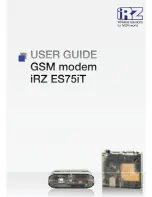
2070-9x User’s Manual
Page 8
FSK Configuration Switches
Switch
Pos
.
FUNCTION
1
Full Duplex (ON)
Off for Half
2
Half Duplex (ON)
Off for Full
3
RTS timing ON =
short timing
4
Soft Carrier Timing
ON=Short timing
5 Rec
Squelch--ON
for Half duplex
6 Rec
Squelch
Timing ON for
short timing
7 Carrier
Detect
timing ON for
short timing
8 Anti-Streaming
ON=enabled
For normal 4 wire Full Duplex
operation, switch 1 should be ON and
everything else should be OFF. This
will select standard timing and full
duplex operation. If Anti-Streaming is
required, turn switch 8 ON.
For Normal 2 wire Half Duplex
operation, switches 2 and 5 should be
ON and everything else is OFF. Turn
switch 8 ON if Anti-Streaming is
required. Only the Audio Out
transformer is used for 2 wire
operation. Switch 2 connects the input
amplifier of the receiver to the board
side of the Output transformer so that
signals coming into the transformer
are available to the receiver. Switch 5
enables the Receiver Squelch, which
turns RXD OFF when the Modem is
transmitting.
In the 4-wire full duplex mode of
operation, there is no connection
between the Transmitter circuit and
the Receiver circuit. In the 2-wire
mode, the transmitter output is
connected to the Receiver input.
For further adaptation, all of the timing
signals can be configured to be half
their normal time. Switch position 3
reduces the CTS delay to 6ms.
Position 4 reduces the Soft Carrier
time to 5ms. Position 6 reduces the
Receiver Squelch time to 3.2ms. (This
is the time, in a 2 wire half duplex
system, that the Receiver is held OFF
after a transmission). Switch position
7 reduces the Carrier Detect time to
4ms.
These faster timing can be used in a
system where you are running out of
time in polling a large number of
intersections. While the faster timing
will allow for more modems in the
same network, it also allows for more
system errors. All modems have to be
set for the faster timing.
Switch position 8 on the dipswitch
turns the Anti-Streaming circuit on
and off. The Anti-Streaming circuit will
turn off the Transmitter after it has
been transmitting for 7 seconds
continuously. This will prevent a
single malfunctioning Controller from
interfering with other remote modems
on the same line. This feature is
typically used on remote/slave
modems where the transmitted data
packets are short. The anti-streaming
circuit will be active until RTS is de-
asserted. When RTS goes low, the
anti-streaming circuit will reset
automatically and the Controller can
then transmit again.
PRELIMINARY









































